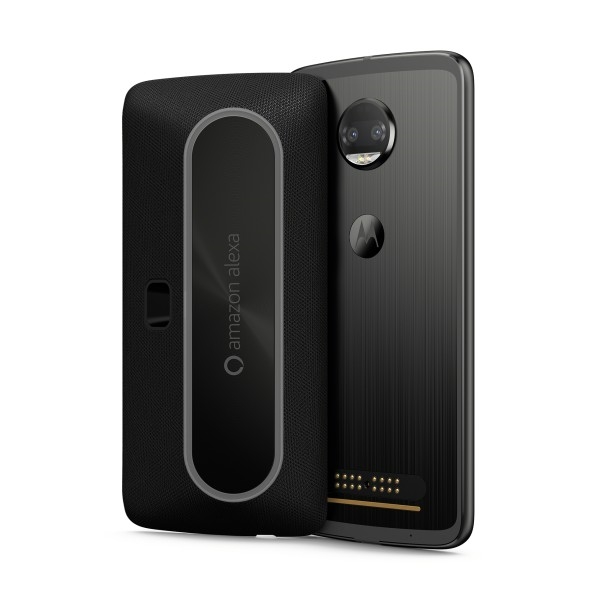Motorola’s Modular Smartphone Dream Is Too Young To Die
In the summer of 2016, Lenovo’s Motorola unit did something unusual for an Android phone maker: It announced an ambitious idea for a new kind of phone, and then vowed to stick with it for several years.
To distinguish the Moto Z from other high-end Android phones, Motorola offered a set of “Moto Mods” that could snap onto the Moto Z’s backside, adding features like a better speaker, a 10x optical zoom camera lens, and a backup battery pack. And instead of just pushing the concept on its own, Motorola turned to accessory makers and entrepreneurs for help, promising that whatever they built would work with three generations of Moto Z phones.
Eighteen months later, more than a dozen Moto Mods are now available, including a hands-free Alexa speaker, a game controller, a magnetic car dashboard mount, and a Polaroid photo printer. Meanwhile, an accelerator program for independent mMd makers is close to yielding its first product–a snap-on physical keyboard–after more than a year of development. After all this time, the modular hardware ecosystem seems close to paying off.
But amid broader struggles at Lenovo, it’s unclear how much longer the idea will last. Lenovo has acknowledged that its $2.9 billion acquisition of Motorola from Google in 2014 hasn’t led to smartphone profits as planned, and last month the company confirmed layoffs to the Motorola team in Chicago. Although Lenovo says work on the Moto Z and Moto Mods will continue–and a new version of the phone is rumored for later this year–the company will only speak in generalities about the future.
“We’re committed to the freedom modularity brings consumers and are looking forward to being at the forefront as the market evolves in the coming years,” Jeff Snow, Motorola’s general manager for Moto Z and Moto Mods, said in an emailed statement. “We don’t have any specifics on upcoming products to share at this time.”
The uncertainty leaves Moto Mod makers in a tough spot. Just as they’re getting a handle on how to work with Motorola’s unique hardware and software, they’re bracing for the possibility that after this year–or maybe even sooner–everything they’ve learned and worked for will become obsolete.
Not that Motorola is in a much better position. While tech enthusiasts have dreamed of modular phones for years (see: Phonebloks and Google’s Project Ara), it’s still unclear whether mainstream consumers are interested in the concept. And the only way for Motorola–or anyone–to know for sure is to keep placing faith in the ecosystem it’s spent so much time creating.

Learning To Mod
Mod creators say Motorola has been a source of encouragement as they dream up new ideas. When Thomas Lancer submitted an idea for a battery pack with fold-out charging prongs in February, for instance, he received an email the next day from Stephen McDonnell, the head of the Moto Mods program, who wanted to discuss the idea further.
Lancer believes his idea, which would let users recharge their phones without carrying cables around, could be a killer application for Moto Mods, and felt emboldened after talking to McDonnell. He assembled a team from one of his past jobs as a technology consultant on felony criminal prosecutions, and quickly got to work on an Indiegogo campaign. It’s one of six campaigns that Motorola is now spotlighting as future potential Mods.
“I wouldn’t have been as interested, but you get the impression they want you to succeed,” Lancer says.
Still, developing Moto Mods isn’t easy. Although Motorola provides Mod creators with a development kit for making prototypes, designing a mass-produced project around the phone’s modular controller components takes a lot of extra work.
Liangchen Chen learned this firsthand while designing the physical keyboard Mod that Motorola has been demo-ing at tech trade shows this year. Chen and his company Livermorium were among 13 finalists in a developer contest Motorola held in April 2017–including two that were eligible for venture funding from Lenovo Capital–but the keyboard is the only one that appears to be near completion.
Motorola’s top two finalists in that contest included a rear e-paper display Mod and a digital audio converter Mod for music recording. The creators on those projects did not respond to requests for comment, but Motorola says it’s still working with one candidate on opportunities for “a more formal prototyping stage along with commercial prospects.”
Chen speculates that those projects’ creators underestimated the difficulty of integrating Motorola’s modular connector hardware with their product concepts.
“It’s actually more difficult than it looks,” he says. “It’s not something you can do with a few hobby engineers, or just one or two engineers. You really need a team to specialize.”
It’s unclear whether larger brands such as Mophie and Incipio, which both built Moto Mod battery packs, went through similar challenges. Those companies and zoom lens maker Hasselblad declined to comment on their experience. Motorola’s Jeff Snow would only say that “we work closely with major brands throughout the entire process of development, sales and marketing of Moto Mods.”
Avi Greengart, an analyst with GlobalData, wonders if Motorola had a bigger hand in product development with those companies.
“We talk about some of these devices where we’re not sure who made them, I think it’s essentially because Motorola probably brought them most of the way to market,” he says. “But to do that, there are only a limited number of partners you can work with.”
If that’s the case, Chen’s keyboard mod is all the more remarkable, and could mark a turning point in Moto Mod development. After a year of getting to know the platform, Chen believes his company could easily develop new mods, or even work with Motorola to help other Mod makers create new products at a faster clip.
“We have learned all the parts for the controller, and we know how the hardware works, and how the software platform works, so if there’s a good idea coming, we could make it much quicker than people working from scratch,” Chen says.

Locked In
Despite Chen’s efforts, Motorola has plenty of reasons to walk away from Moto Mods now.
For one thing, the Moto Z line must always retain its current size to work with the current batch of Moto Mods. So while other phones are getting smaller by shrinking the bezels around the screen, Motorola can only provide a larger screen in its existing frame. That may explain why the Moto Z3 is rumored to have a 6-inch display.
“The challenge is, by doing the accessories on an old form factor, they’ve been locked into that form factor when the market moved on,” Greengart says.
The other problem, Greengart says, is more fundamental: People generally don’t buy a particular phone just to access its accessories. So no matter how good Moto Mods get, they may never justify the investment that Motorola is putting into them.
“When you’re competing against Apple and Samsung, those are highly polished products with tremendous brand recognition,” Greengart says. “You need to be able to compete with them and get people to buy your phone, and only then do accessories start playing into the purchase decision.”
One likely scenario, then, is continued support for Moto Mods, but with less ambition. A recent report by Android Police said Motorola would be moving away from “niche mods” in favor of ones with broader consumer appeal. That could include more batteries and speakers, which Greengart says have been the most popular Mods to date. (Motorola didn’t confirm or deny the report, but says its Mods are “made with consumers in mind.”)
By scaling back the Mod program, Motorola wouldn’t have to worry about stocking retail shelves with low-demand products or investing in ideas that may not pan out. But this would also be a sad way to start winding down a program that once had so much promise, and that developers were just starting to figure out.
Despite the uncertainties, Thomas Lancer is hoping the modular concept will survive. After the initial reports of layoffs at Motorola, he was relieved to hear that Moto Z development was continuing, and that Moto Mods head Stephen McDonnell was still on board. Likening the Mod community to never-say-die fans of Joss Whedon’s Firefly TV series, he says that he hopes the idea will “at least survive long enough to show people that this modular architecture is a fun, interesting idea. And maybe the Z Series won’t be exactly the same three years from now, but maybe it’ll exist.”
Correction: The research firm Avi Greengart works for is now known as GlobalData, not Current Analysis.
(24)



